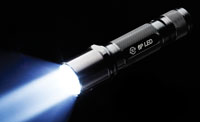

lluminate, Identify, Incapacitate. This is the defensive triad of any good tactical lighting system, whether it’s truly a “tactical light” (one developed with SWAT teams as the end users) or a patrol-type light for general use by officers on a daily beat. Let’s break down the concept a bit.
Illuminate
 First, all flashlights are designed to illuminate. They help us clearly define an area in total darkness, allowing us to maneuver or navigate safely. Any light can do that to varying degrees, and that’s what most police patrol and civilian flashlights are designed to do at a minimum.
First, all flashlights are designed to illuminate. They help us clearly define an area in total darkness, allowing us to maneuver or navigate safely. Any light can do that to varying degrees, and that’s what most police patrol and civilian flashlights are designed to do at a minimum.
Identify
The next “I” of the triad is identify. Here the flashlight concept becomes more specialized because we’re talking about threat identification. Are we looking at friend or foe? It’s this area in which previous generations of incandescent lights with halogen or krypton bulbs fall flat. They simply don’t have enough lumens and candelas to do the job.
Lumens and candelas are the more modern terms used to define light output, as opposed to the older measurement of candlepower. Lumens measure light output at the source, while candelas measure the light that falls on a surface. As the area of the surface increases, the number of candelas will decrease even as the number of lumens remain constant.
The beams from the old tech lights can only identify a small centralized viewing area, allowing the user to see possibly only the face and hands of a person, and not necessarily both at the same time. Even with the best of those ancient generations of lights there was a lot of shifting of the beam from hands to face during any type of confrontation because you couldn’t see what you needed to see —the face and hands at the same time. With modern lighting systems, that technique is no longer necessary.
Incapacitate
The final “I” is incapacitate. The concept was pioneered by the Surefire Corporation in the early 1990s: Use the light as a part of the combat arsenal to incapacitate a suspect through disorientation.
Using a light to disorient a suspect was first used with the Surefire incandescent xenon gas bulb 6P lithium battery-powered lights. The strategy is now applied to the latest generations of patrol lights.
The understanding of this concept is critical. In the old days, the best we could do was illuminate and identify our opponent. With today’s more powerful and flexible lights, we can use the light system to disorient and stun the opponent. If we don’t bring enough light (an update of the adage “bring enough gun”) to “stun” our opponents, they can use our illumination source as a target to shoot at.
This article is an excerpt from Own the Night: Selection and Use of Tactical Lights and Laser Sights by Scott Wagner.



![Best Concealed Carry Guns In 2025 [Field Tested] Wilson Combat EDC X9S 1](https://gundigest.com/wp-content/uploads/Wilson-Combat-EDC-X9S-1-324x160.jpg)


![Best 9mm Carbine: Affordable PCCs [Tested] Ruger Carbine Shooting](https://gundigest.com/wp-content/uploads/Ruger-Carbine-Shooting-100x70.jpg)
![Best AR-15: Top Options Available Today [Field Tested] Harrington and Richardson PSA XM177E2 feature](https://gundigest.com/wp-content/uploads/Harrington-and-Richardson-PSA-XM177E2-feature-100x70.jpg)
